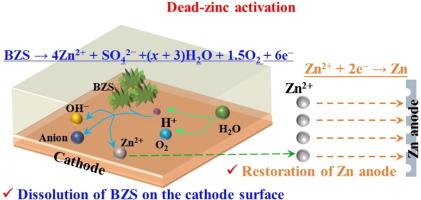基于一种有效的死锌活化方法解开空气可充电锌基水电池的难题
IF 14.9
1区 化学
Q1 Energy
引用次数: 0
摘要
空气可充锌基水电池具有典型的空气自充特性。不幸的是,它们的进一步发展受到两个主要挑战的困扰:由于在阴极表面沉积的“死锌”(碱性锌盐,BZS)的形成,空气充电寿命超短;由于在空气充电过程中锌的持续消耗,Zn阳极受到严重腐蚀。为了解开这些纠结,本文提出了一种有效的原位电化学转化死锌活化方法,成功地激活了BZS中的“死锌”,同时修复了锌阳极。具体来说,由于大量死锌的形成,氮掺杂分层多孔碳(NHPC)的比放电容量在0.2 A g−1下,仅在第5次充气后就从132.4 mAh g−1迅速下降到36.8 mAh g−1。为了恢复这些失效的NHPC电极,我们巧妙地利用原位电化学转换的支持,成功地消除了恒流充电过程中NHPC上的BZS。更重要的是,该方法还可以从“死锌”中回收锌资源,以修复锌阳极,为解决锌的持续消耗问题提供了可行的解决方案。结果表明,在0.2 a g−1条件下,NHPC的空气可充电比容量由36.8 mAh g−1提高到118.9 mAh g−1。同时,通过一系列的原位/非原位试验,揭示了电荷存储、空气充电和原位电化学转化的相关机制。这项工作为ARAZBBs更广泛的实际应用奠定了基础。本文章由计算机程序翻译,如有差异,请以英文原文为准。

Untying the Gordian knots of air-rechargeable aqueous Zn-based batteries based on an effective dead-zinc activation method
Air-rechargeable aqueous Zn-based batteries (ARAZBBs) possess their typical air self-charge advantage. Unfortunately, their further development is beset by two major challenges: an ultrashort air-charge lifespan due to the formation of ‘dead Zn’ (basic zinc salt, BZS) deposited on the cathode surface and the severe corrosion of Zn anode due to continuous consumption of Zn during the air-charge process. Aiming at untying these Gordian knots, herein, an effective dead-zinc activation method of in-situ electrochemical conversion successfully activates ‘dead zinc’ in BZS and repairs the Zn anode simultaneously. Specifically, the specific discharge capacity of as-prepared nitrogen-doped hierarchically porous carbon (NHPC) declines rapidly from 132.4 to 36.8 mAh g−1 at 0.2 A g−1 after only the 5th air-charge due to a large amount of dead zinc formation. To recover these failed NHPC electrodes, we skillfully draw support from in-situ electrochemical conversion to successfully eliminate BZS on the NHPC during the galvanostatic charging process. More importantly, the method also recovers Zn resources from ‘dead zinc’ to well repair Zn anode, providing a viable solution to address the issue of continuous consumption of Zn. As a result, the air-rechargeable specific capacity of NHPC has been significantly improved from 36.8 to 118.9 mAh g−1 at 0.2 A g−1 by using this effective dead-zinc activation method. Meanwhile, related mechanisms to charge-storage, air-charge, and in-situ electrochemical conversion are clearly revealed by a series of in-/ex-situ tests. This work lays the foundation for the wider practical application of ARAZBBs.
求助全文
通过发布文献求助,成功后即可免费获取论文全文。
去求助
来源期刊

Journal of Energy Chemistry
CHEMISTRY, APPLIED-CHEMISTRY, PHYSICAL
CiteScore
19.10
自引率
8.40%
发文量
3631
审稿时长
15 days
期刊介绍:
The Journal of Energy Chemistry, the official publication of Science Press and the Dalian Institute of Chemical Physics, Chinese Academy of Sciences, serves as a platform for reporting creative research and innovative applications in energy chemistry. It mainly reports on creative researches and innovative applications of chemical conversions of fossil energy, carbon dioxide, electrochemical energy and hydrogen energy, as well as the conversions of biomass and solar energy related with chemical issues to promote academic exchanges in the field of energy chemistry and to accelerate the exploration, research and development of energy science and technologies.
This journal focuses on original research papers covering various topics within energy chemistry worldwide, including:
Optimized utilization of fossil energy
Hydrogen energy
Conversion and storage of electrochemical energy
Capture, storage, and chemical conversion of carbon dioxide
Materials and nanotechnologies for energy conversion and storage
Chemistry in biomass conversion
Chemistry in the utilization of solar energy
 求助内容:
求助内容: 应助结果提醒方式:
应助结果提醒方式:


